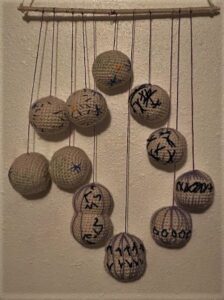 To help understand how mitosis works I created a moble of each stage using amigurumi and embroidery. The colors were to represent the historical part of the paper and to show how far we have gotten to understand mitosis. Amigurumi is a Japanese style of crocheting small aminal, dolls, or any 3D object. This art style came to the United States in the early 2000s. This style of crochet was not easy for it takes a lot of focus but it’s fun a single ball took about 5 hrs to complete for you are using small hooks and yarn so that there are no gaps, a quick side note I’m not that good at embroidery so that’s another reason why it took a while. Each part is made separately and match the shape of a drawn moble of the mitosis stages. The navy blue is the chromosome of the cell which is why they move and change size long with shape in each step. The purple represents the Microtubule and spindles which are contented to the pole, the pole is the top of the shaper where the string is coming out of. Green is the chromatin which may be hard to see for its fabric makers. Centrioles are colored blue where the nuclei are light blue embroidery thread and the yellow is the nucleus. This piece of art was fun and creative to do I had to make my own pattern for the anaphases and the telophase which help mater with my amigurumi.
To help understand how mitosis works I created a moble of each stage using amigurumi and embroidery. The colors were to represent the historical part of the paper and to show how far we have gotten to understand mitosis. Amigurumi is a Japanese style of crocheting small aminal, dolls, or any 3D object. This art style came to the United States in the early 2000s. This style of crochet was not easy for it takes a lot of focus but it’s fun a single ball took about 5 hrs to complete for you are using small hooks and yarn so that there are no gaps, a quick side note I’m not that good at embroidery so that’s another reason why it took a while. Each part is made separately and match the shape of a drawn moble of the mitosis stages. The navy blue is the chromosome of the cell which is why they move and change size long with shape in each step. The purple represents the Microtubule and spindles which are contented to the pole, the pole is the top of the shaper where the string is coming out of. Green is the chromatin which may be hard to see for its fabric makers. Centrioles are colored blue where the nuclei are light blue embroidery thread and the yellow is the nucleus. This piece of art was fun and creative to do I had to make my own pattern for the anaphases and the telophase which help mater with my amigurumi.

Andrea created a hanging mobile to present a fun and creative way of showing the stages of mitosis. This unique mobile contains handmade balls of yarn made in a style of Japanese crocheting called amigurumi, typically used to create 3D objects. Andrea combined amigurumi with embroidery to create pictures on the surface of the balls of yarn. These focused stitches clearly show the stages of mitosis within a cell, each ball representing its own stage of the process. Colors also play an important role in this piece. Navy blue, for example, represents the chromosome within the cell, and purple represents the microtubule and spindle. Green represents chromatin, blue shows centrioles with the nuclei and nucleus being light blue and yellow respectively. Colors are important to this piece because of their historical role in the discovery of mitosis. Walther Flemming was the first to discover the stages of mitosis within the cells of a salamander, which he chose due to a salamander’s large chromosomes (about 10 times the size of human chromosomes!). Flemming used colored dyes, which helped observe the chromosomes as they went through the stages of mitosis. Similarly, Andrea used colors to help identify the components and stages of mitosis. Andrea put a lot of effort into her STEAM project, taking about 5 hours for each individual ball, which, in one sitting, would have taken about two and a half days to complete, not including the research and essay that accompany the project. Andrea created an interesting project using unique methods to show the stages of mitosis in a clear and well-thought manner.